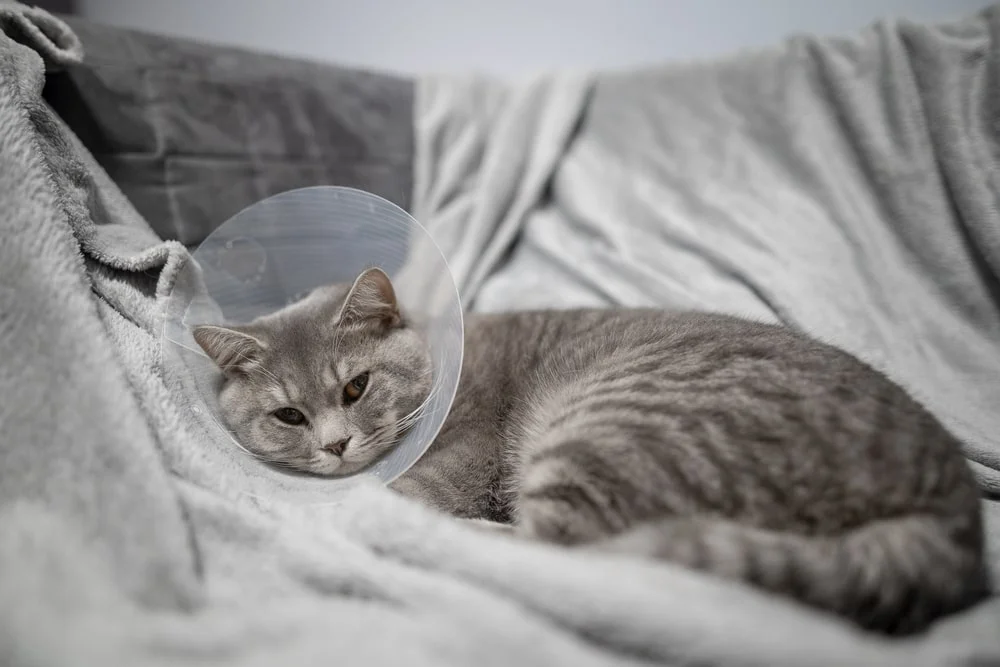PET HEALTH
It can be all too easy for a cat to get injured, even if they spend their days indoors. If you notice your cat has an open wound or has been injured, your first step should be taking them to the vet as quickly as possible for treatment. But it’s also important to know about at-home cat wound care — just in case your kitty needs immediate attention or if professional help isn’t available.
Types of Cat Wounds
There are two general types of wounds your cat may suffer: open and closed.1 An open wound could be a cut or puncture caused by a sharp object or animal bite. These are often the most dangerous, as they can lead to bleeding and infection, but they're also the easiest to identify and treat immediately.
Closed wounds can be a bit trickier. These include abrasions, bruises, sores, and abscesses that form beneath the skin. If you can’t visually identify the wound, look for secondary signs that your cat is in pain, such as frequent licking of one spot, reduced appetite or energy, and general behavioral changes.
Regardless of the type of wound, your best bet is to take your cat to the vet as soon as possible.
Accidents Happen, Pet Insurance Can Help
How To Heal an Open Wound on a Cat
When caring for an open wound, your first step should be to stop the bleeding.2 Locate the wound and apply pressure using gauze or some other clean, absorbent material. Cover this with a bandage or clean cloth to shield the wound from infection while you take your cat to the vet.
You may also want to elevate the wound above your cat’s heart during transportation. Gravity will help reduce the amount of blood flowing to the area and should mitigate some of the bleeding.
Your vet will assess the severity of the wound. Minor abrasions and lacerations may need little more than to be cleaned and allowed to heal on their own. However, more severe open wounds may need to be surgically closed.
What ointment can I put on a cat wound?
It’s important not to apply any disinfectants or topical ointments to the wound unless your vet instructs you to do so. Ointments can interfere with the healing process and may inadvertently cause tissue damage or infection.2 This goes for wound aftercare as well. Don’t use any topical treatments unless specifically instructed by your vet.
How To Tell if a Cat Wound Is Infected
Next to bleeding, infection is the biggest danger posed by open wounds. You should always assess the wound for signs of infection, both before and after veterinary treatment. Indicators of an infected cat wound include:2
- Fever
- Abscess formation
- Noticeable changes in your cat’s behavior
- Signs of discomfort or pain
- Pus discharge
The longer a wound remains open before treatment, the more likely an infection will occur. Should this happen, your vet may decide to leave the wound open rather than stitching it shut. This, along with the use of antibiotics, can actually help combat infection. It will also allow fluid discharge to cleanly drain from the wound, rather than build up beneath the skin.2
Cat Wound Healing Stages and General Care
Your cat will go through three general stages of recovery: inflammatory, proliferative, and remodeling.3
These are natural processes enacted by the body and are helped along by veterinary treatment. The inflammatory stage helps reduce bleeding while also flushing out damaged cells and foreign debris. The proliferative stage sees your cat’s body begin the work of repairing the wound over a period of time. Finally, the remodeling stage induces scarring to reinforce the wounded area and may take up to 2 years to complete.
Depending on the nature and severity of the wound, your vet may assist the healing process via stitching or other forms of surgical closure. Once your cat is free to go home, it’ll be up to you to ensure the healing continues by following your vet’s aftercare instructions. This may include:2
- Cleaning the wound up to three times per day (using only warm water or a diluted antiseptic solution)
- Daily bandage changes
- Antibiotics to combat and/or prevent further infection
Keep an eye on your cat for any changes in their behavior, or changes to the wound, that could indicate infection. If you suspect the cat wound is not healing, take your cat back to the vet for a closer look and professional advice.
How Pet Insurance Can Help With Cat Wound Care
Dealing with your kitty’s injury can be scary. The last thing any pet parent wants to think about at stressful times is money, but the cost of treatment can run into the thousands, depending on the severity of the wound. Fortunately, a cat insurance policy could reimburse you for up to 90% of the covered expenses involved.4
MetLife Pet member Dwight was a young Siberian kitten when his parents took out an insurance policy. They did so just in time. Not long after, Dwight had to be hospitalized for a bite wound caused by another animal. The bill for his treatment and recovery came in at over $13,000 — but Dwight’s insurance plan reimbursed his parents for $10,000. This left them with a much more affordable bill to deal with, and far less stress, while they focused on Dwight’s recovery.5
With pet insurance from MetLife Pet, your cat could get the care they need no matter the price. Read more about our coverage to find out if pet insurance really is worth it, or get started on a free quote now.
Help Protect Your Cat From Pain
Dr. Hunter Finn has been paid by MetLife to discuss the importance of choosing pet insurance. He is an integrative veterinary expert first, and social media star second. He owns Pet Method in McKinney, Texas, where he cares for pets while prioritizing their emotional well-being. When he’s not at his clinic, he’s starring in viral videos on TikTok (2 million followers) and Instagram (500K followers) — where he’s been known to snuggle puppies and conquer the latest dance trends.



